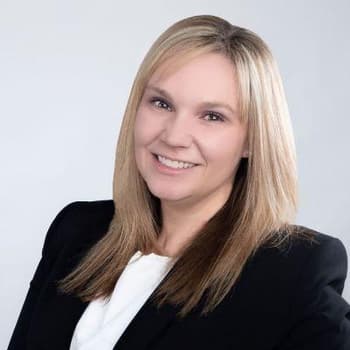Survey Data: Trends of Alcohol use and Recovery in the American South
Written by Nicole LaNeve
& Medically Reviewed by Denise-Marie Griswold, LCAS
Updated 06/17/2022
The Recovery Village recently surveyed over a thousand American adults (ages 18 and older) residing in the southern United States about alcohol use, finding insights on first-drink statistics, mental health, physical health, and recovery across the region. Find out what they said.
If you have ever taken a road trip in the United States, you may have noticed how quickly the scene changes from one unique backdrop to the next. From California to New York to Texas to Florida, each state has a variety of unique traits with their own landscapes, cultures, conversations, economies and social trends.
This geographic variance inspired us to better understand how the recovery experience differed across regions, starting with the south. The Recovery Village conducted a survey of 2,136 American adults (ages 18 and older) about alcohol use, mental health, physical health, and recovery.
We used our survey data to compare national and geographic trends for one of the most misused substances nationwide, alcohol. We found some variances that made the south unique, such as rates of some health complications like depression, high blood pressure and liver disease or their willingness to search for a recovery community. Some metrics, however, were more universally constant, like healthy lifestyle strategies for preventing relapse.
See Also:
Survey Results
First Drink
The years of early adulthood are important to forming healthy consumption habits. Over 90% of the alcohol consumed by the teenage group can be classified as binge drinking and this age range is universally accompanied by a greater percentage of introductory consumption behavior. This is an especially risky intersection of behavior and environment. Our survey data suggests this trend is constant, as “first drink” statistics of southern respondents were in line with national respondents.
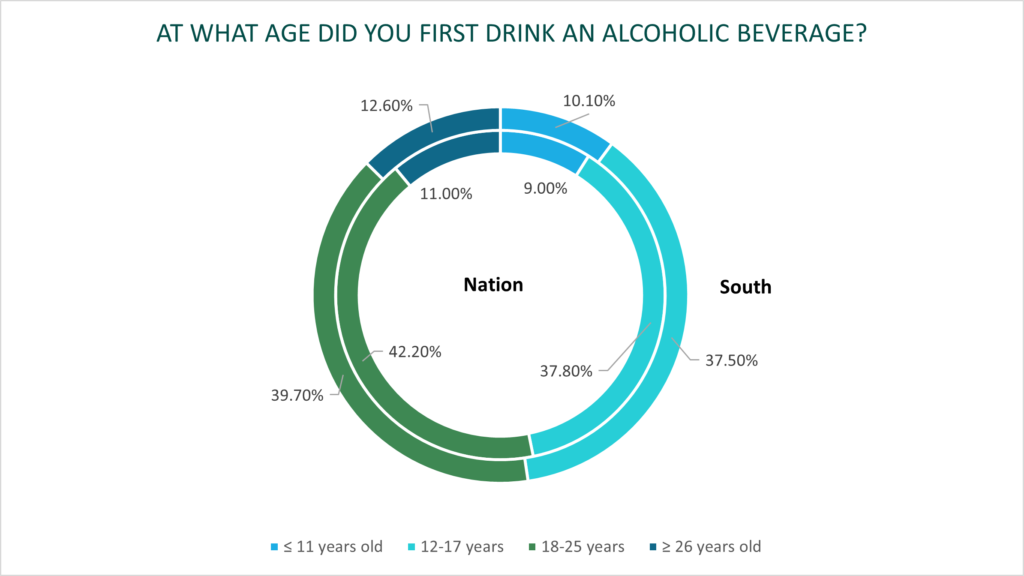
The rate at which southern respondents qualified as “heavy” alcohol users, was also in line with the national average (47.9% versus 47.1% nationally).
Consumption Reasoning
Reasons for drinking across southern states were in line with national trends and were reported as follows:
- 60.4% used alcohol to cope with stress (to relax, unwind, or deal with life)
- 42.5% used alcohol to cope with mental health symptoms like anxiety or depression
- 59.0% used alcohol recreationally or socially
- 36.0% used alcohol out of boredom
- 17.8% reported being physically dependent on alcohol
- 19.4% used alcohol as part of their daily routine (i.e., a drink with dinner)
Alcohol’s Impact on Quality of Life and Health
Unhealthy consumption habits can have drastic impacts on one’s life. The obvious side effects of alcohol misuse such as impacts on physical and mental health can lead to a variety of health complications. The external side effects of alcohol misuse on one’s life are often present but commonly ignored and can range from impacting career and financial position to personal relationships and parenting. The southern survey respondents were slightly more likely to report some adverse effects on their lives compared to national results:
- 55.5% (vs. 53.5%) reported alcohol affected their physical health
- 49.4% (vs. 44.5) reported alcohol affected their mental health
- 46.0% (vs. 41.9%) reported alcohol affected their relationships with loved ones
- 33.4% (vs. 34.0%) reported alcohol affected their finances
- 29.7% (vs. 29.5%) reported alcohol affected their hygiene
- 27.7% (vs. 25.3%) reported alcohol affected their career or job
- 24.1% (vs. 21.7%) reported alcohol affected their abilities as a parent
- 11.9% (vs. 13.2%) reported alcohol affected their legal status (incarceration, fines, etc.)
Southern heavy drinkers were much more likely to report these effects compared to light or moderate drinkers. They were twice as likely to say that drinking impacted their mental health, their legal status and their abilities as a parent. They were two and a half times more likely to say it impacted their relationships with loved ones.
When residents of the southern states were asked to rank the areas alcohol use most impacted their lives, the results echoed our national survey with the heaviest impacts being: physical health, mental health and relationships.
Survey participants were asked to weigh alcohol’s impact on their health, by specifying physical and mental health complications related to alcohol misuse. Southerners were more likely to report depression, high blood pressure and liver disease.
Related Topic: Alcohol and Depression
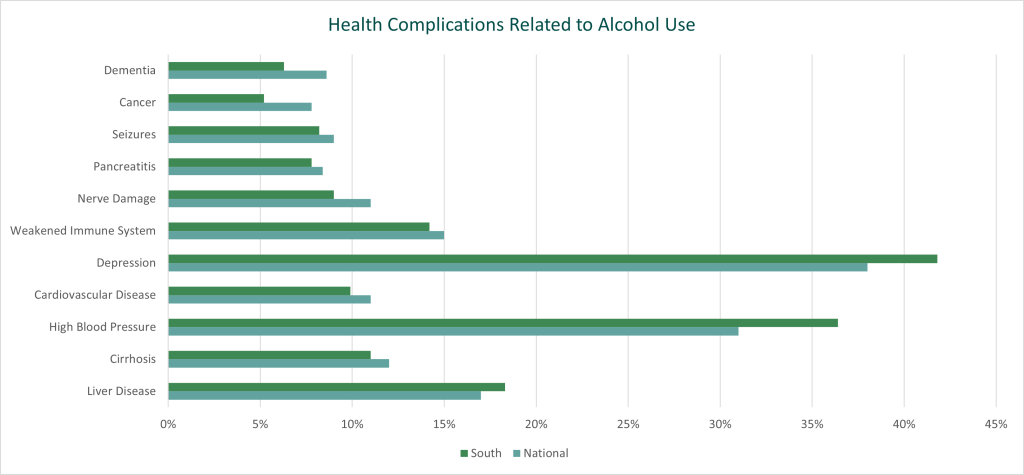
Again, those that qualified as heavy drinkers increased their chances for these effects. Southern heavy drinkers were:
- 4.4 times more likely to report nerve damage
- 3 times more likely to have seizures
- 2.4 times more likely to report cirrhosis
- 2 times more likely to have liver disease
Detox, Rehab, and Recovery
We found that residents of the southern geographic area were more likely to seek out support from communities during their recovery journeys, such as a support group or rehab facility, than their national counterparts.
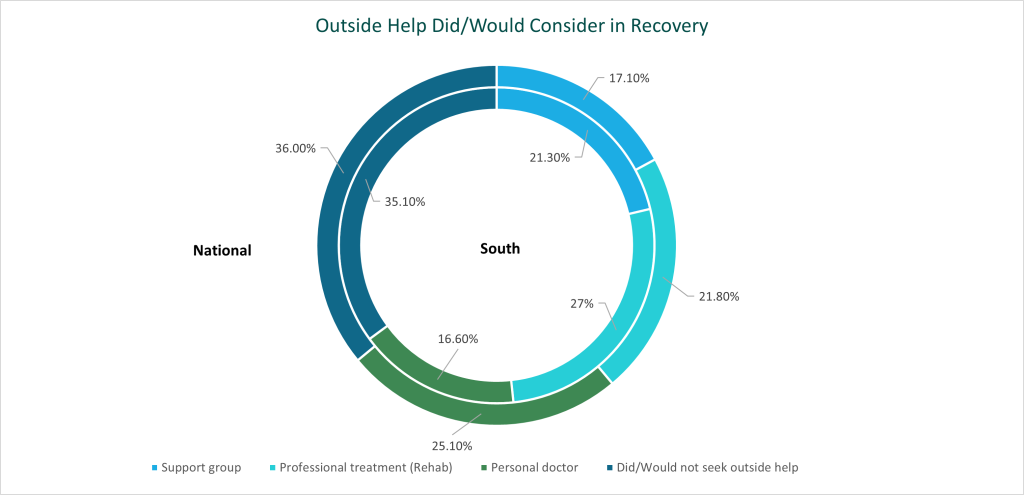
While southern residents were more open to seeking outside help during recovery, our study found that 35% did not or would not consider outside help.
This statistic is discouraging because detoxification can be one of the most physically demanding parts of recovery from alcohol abuse. Seeking professional and community support is a powerful tool for anyone beginning their recovery journey and is strongly encouraged. Taking advantage of these resources can make a difficult experience more comfortable and significantly safer, especially when facing the most severe alcohol withdrawal symptoms.
Strong communities can be the pillar of strong recovery, but not all detoxifications and recoveries are made equally. Some detox and recovery journeys can result in physically and psychologically demanding withdrawal symptoms. On average, respondents reported withdrawal symptoms lasting 4.66 days and ranging anywhere between 2 and 8 days in 95% of respondents.
Southern respondents reported experiencing a wide range of withdrawal symptoms when detoxing from alcohol:
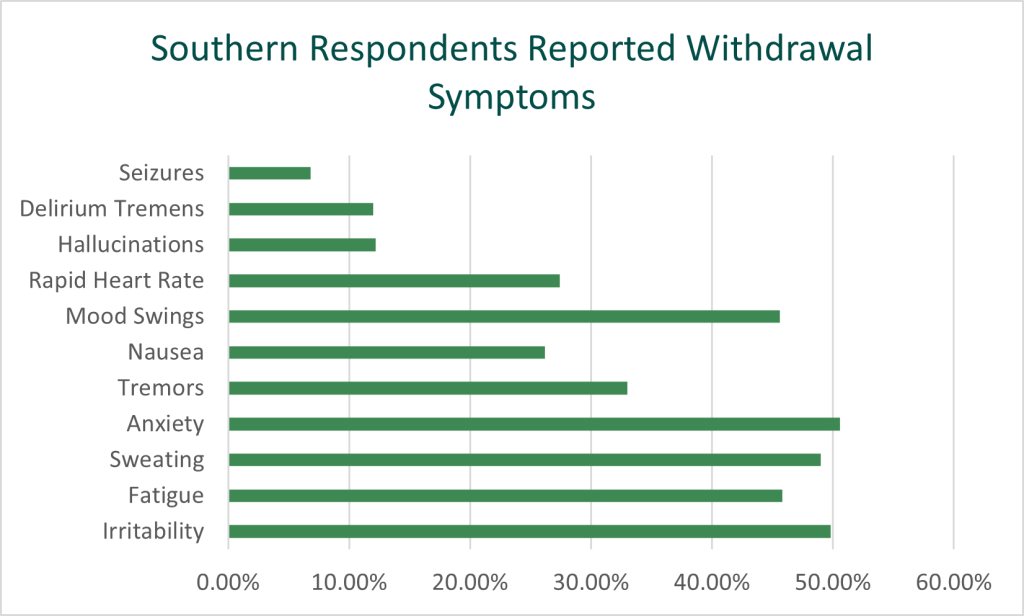
Southerner heavy drinkers were 3 times more likely to experience hallucinations. They were also 3 times more likely to experience seizures. Most troubling, these heavy drinkers were 2.7 times more likely to experience Delirium Tremens (DTs), a potentially fatal side effect of alcohol withdrawal.
Individuals detoxing from heavy alcohol consumption and those detoxing from polysubstance use (I.e., detoxing from multiple substances) faced a significantly more challenging detox and reported higher rates of withdrawal symptoms in every category.
Heavy Drinkers:
- 54.5% respondents reported irritability
- 51.5% reported fatigue
- 54.1% reported sweating
- 57.1% reported stress or anixety
- 43.3% reported hand tremors
- 32.1% reported nausea or vomiting
- 46.3% reported mood swings
- 35.1% reported rapid heart rate
- 17.2% reported hallucinations
- 16.4% reported Delirium tremens (DT)
- 9.7% reported seizures
Polysubstance Use:
- 56.4% respondents reported irritability
- 57.4% reported fatigue
- 56.4% reported sweating
- 60.4% reported stress or anixety
- 40.6% reported hand tremors
- 32.7% reported nausea or vomiting
- 51.5% reported mood swings
- 37.6% reported rapid heart rate
- 23.8% reported hallucinations
- 15.8% reported Delirium tremens (DT)
- 12.9% reported seizures
In these circumstances, a medical detox in a professional community such as a rehab facility or medical center may be much safer, more comfortable, or even necessary. Our research echoes this, as individuals completing polysubstance detox were 2.5 times more likely to detox at a rehab facility or medical center than at home.
Health, Life and the First Step
If you are ready to stop unhealthy consumption habits, The Recovery Village at Baptist Health can help. Respondents consistently placed lifestyle changes, exercise and avoiding triggers as their top three factors in avoiding relapse. Survey respondents were also 5.5 times more likely to attribute lifestyle changes to their success in recovery than taking medication. These are skills you will learn and develop in treatment at The Recovery Village Baptist Health.
Contact us to learn more about treatment options that could work for you. Recovery can be complex and taking the first step can be intimidating, but with a strong support network and the right frame of mind, you can start your journey to living a healthier, happier life today.
Authorship


 Insurance
Insurance About Us
About Us Our Facility
Our Facility Admissions
Admissions Programs
Programs Medical Detox
Medical Detox Inpatient Rehab
Inpatient Rehab Aftercare & Recovery
Aftercare & Recovery